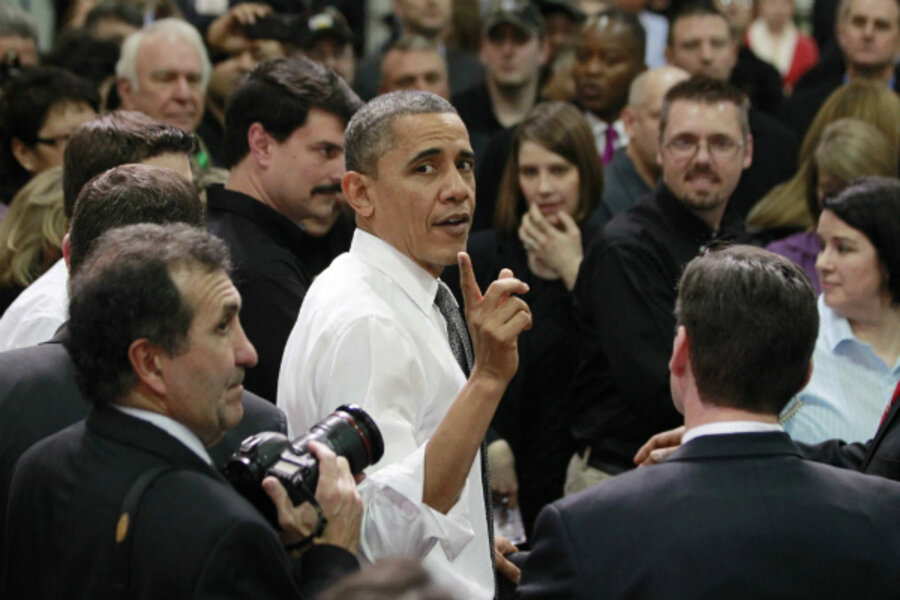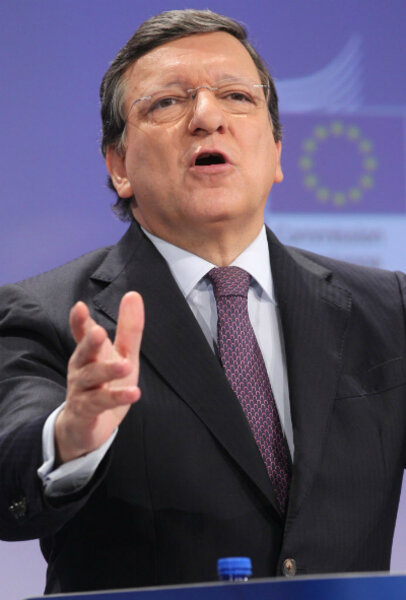In State of the Union, Obama calls for free-trade pacts of historic scope
Loading...
| WASHINGTON
Cheaper Italian pasta in US supermarkets? More Mustangs prowling the byways of Provence?
President Obama’s announcement in his State of the Union address Tuesday night that the United States and European Union will begin negotiating creation of the largest free-trade area in history may have visions of cheaper imports from the other side of the Atlantic dancing in consumers’ heads.
But perhaps the most significant impact of a trade partnership between two mammoth economies that already make up half of all global output – and a third of global trade – would be the streamlined investment rules and product standards and elimination of trade barriers that would become the model for international trade.
“This really is more global than it is bilateral,” says a senior European official.
For both US and EU officials, a transatlantic free-trade deal with global ramifications would be a way of getting around global trade talks launched in 2001, called the Doha Round, which have gone nowhere.
Negotiating a US-EU trade partnership, even as the US is negotiating a Trans-Pacific Partnership (TPP) envisioned as a prototype for a vast Asia-Pacific free-trade area, could mean that before the end of Mr. Obama’s presidency two major pillars of a globalized trading system would be in place.
With two of the world’s dominant economic powers trading based on streamlined and common rules and standards, other economies seeking to take part in the expanding global trading system would find it in their interest to adopt the same or at last similar rules and standards, trade experts say.
"The transatlantic relationship is so intertwined with the global economy that any amount of streamlining of standards and regulatory convergence is going to increase economic growth globally,” says Charles Dittrich, vice president for regional foreign trade initiatives at the National Foreign Trade Council (NFTC) in Washington. “Such a high level of cooperation and convergence between the US and the EU has the potential to serve as a basis for a broader adoption of common trade rules and standards with other countries.”
Still, what explains the renewed enthusiasm for big trade deals? The answer is in the added economic growth – and therefore the new jobs – that many economists say the expansion of free trade would produce.
A report jointly released Wednesday by the US and the EU finds that a transatlantic trade deal would boost the EU’s economy by about 0.5 percent by 2027, and the US economy by about 0.4 percent over the same period.
Yet even with the prospects for a boost in economic growth, no one expects the negotiations, which officials from both sides say could take about a year, to be easy. Experts note that tariffs between the two trading blocs are already low, so the focus will be on streamlined standards and rules.
And reaching common standards on everything from food products to car parts could be daunting. Anyone who knows about the intense and sometimes emotional rows that have divided the two partners in recent years over genetically modified grains, raw-milk cheeses, or chlorine-bathed chicken meat, will have a glimpse of what may lie ahead.
At a press conference in Brussels Wednesday announcing the launch of trade talks, European Commission President Jose Manuel Barroso signaled to EU consumers that a trade deal would not come at the price of their safety. “We will not negotiate changes that we do not want of the basic rules, on either side, be it on hormones [in meat] or GMOs [genetically modified crops]," he said.
Food-safety issues and some aspects of intellectual property rights may turn out to be the toughest sticking points in the coming negotiations, says Mr. Dittrich of the NFTC. Deciding whether or not some potential deal breakers will even be part of the talks will be “the next step,” he adds, since negotiators from the two sides will be deciding in the coming weeks the scope of the talks and just how ambitious an agreement to try to reach.
In the end, the two trading partners may decide to shoot for something less than a full-fledged free-trade accord, but some trade advocates say a substantial agreement reached in relatively short order would be better than getting bogged down in a quest for seamless transatlantic free trade.
And some say that vision of a US-EU trade accord was what Vice President Joe Biden was hinting at when he told an audience in Munich, Germany, earlier this month that “if we go down that road [of negotiating a free-trade agreement], we should try to do it on one tank of gas and avoid protracted rounds of negotiations.”







